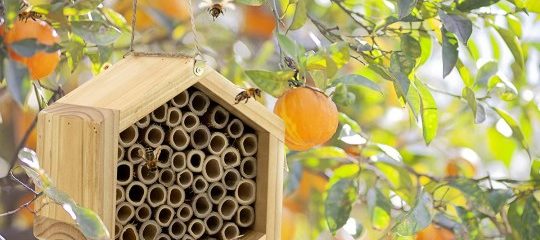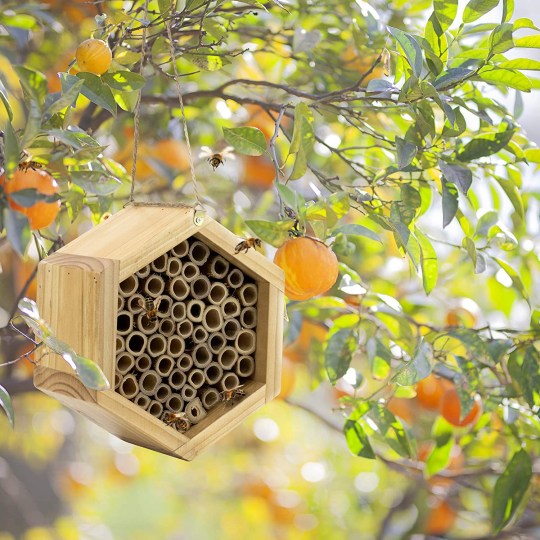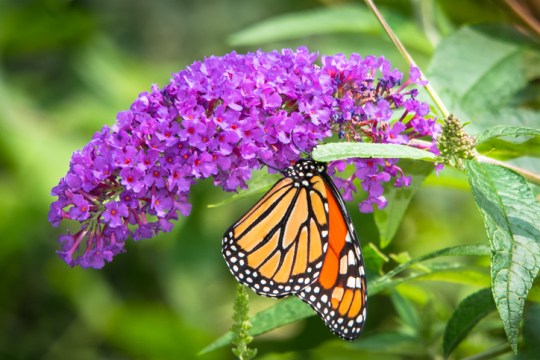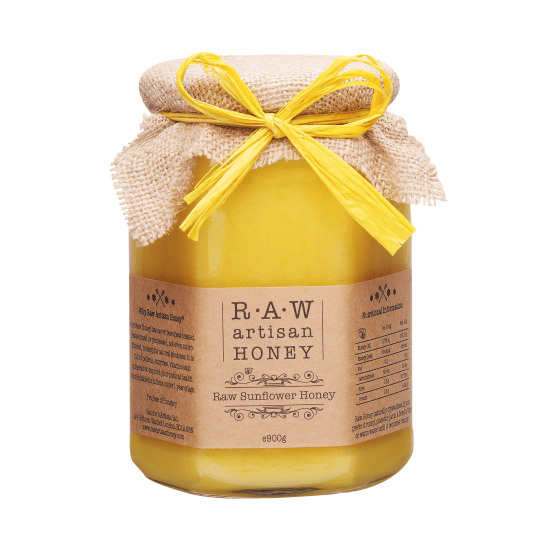di Miranda Larbi –
Bees are in a bad way.
Climate change and an increasingly urban environment have caused loads of trouble for bees and other pollinators, with 13 bee species becoming extinct in the UK since 1900 and another 35 currently languishing on the threatened species list.
Bees aren’t extinct yet but their numbers are falling dramatically. In fact, a study published by Nature Communications found that in the UK alone, the number of wild pollinators has fallen by 33% since 1980 while bumblebee numbers in the USA shrunk by 89% between 2007 and 2016.
97% of our vital grasslands have disappeared in the last 60 years, meaning that bees have lost their most precious habitat.
That’s worrying not just because bees are adorable and deserve to have somewhere to live but they pollinate 75% of our main food crops like apples and tomatoes. That accounts for a staggering £690 million a year of the UK economy.
We need bees to feed ourselves, so their problem is our problem.
1. Build a bee hotel
Bees have their hives, yes, but everyone needs a little Pied a Terre. You can build your own little bee hotel by getting hold of bamboo, cutting it up and tying together with lots of strong string. You can get bamboo plant supports at any garden centre or B&Q – or Amazon. If you’re not into DIY, you can buy ready-built constructions to hang in trees or again on your balcony (I’m not sure if you really want a tonne of bees hanging around your door but you know, the option’s there). Buy a bug and bee backpackers hostel on Etsy for £23.99 or a chic single bed anthracite hotel from Bakker.com for the same price.
2. Keep your windows open
This is a very simple thing we can all do: if you spot a bee buzzing around your home, leave your windows open. Do not interfere because you might stress out the bee, which will prompt it to sting (after which it’ll die). Instead, open your windows and remove any pets you have from the room so that your cats or dogs don’t try to eat it. The bee will eventually fly out. 3. Plant bee-friendly flowers.
3. Plant bee-friendly flowers
Bees go crazy for certain plants. The RHS has a downloadable list of plants for pollinators which will provide plenty of pollen and foliage for all pollinating visitors.
Here are some of the most common ones to plant in your garden or have in bowls on your balcony:
- Comfrey (very hardy and hard to kill)
- Lavender (great for the balcony and for putting in clothes drawers – makes your pants smell delicious!)
- Rosemary (also a balcony winner, this time to cook with)
- Buddleia (you may know them as ‘butterfly bushes’ – they love them)
4. Leave the mowing this month
Last month, a campaigned called No Mow May encouraged gardeners to leave the lawnmower for four weeks – a tall order for many. But longer lawns enable bees to hide from predators and enjoy the pollen of ‘weeds’ like dandelions. This issue is that when media outlets encourage people to leave their lawns wild, they tend to show beauitful pictures of wild meadow. Leaving your lawn won’t look gorgeous – it’s important to make that clear. But it will help bees. You could set yourself a challenge to leave it for four weeks (in this weather, you’ll have to put the sprinkler on) or you could just vow to mow it less. Or you could mow around a wild patch that you leave all year around.
5. Throw a seedbomb
It’s all very well letting your lawn grow and planting delicious shrubs, but what bees really love is wild flowers.
Transform your unloved spaces (the places you haven’t cultivated yet) with a Guerrilla Gardening grenade. They’re packed with wildflower seeds that will grow into flowers loved by bumblebees and honey bees. Pull the pin, shake it, give the patch a spray of water and that’s it. Oh, and the actual bomb biodegrades.
If you only have a balcony, stick your grenade on top of some soil in a pot that’s got a 15cm diameter. Get one for £3.95 from Not On The High Street.
6. Get a bee saver guide
If you don’t know your leafcutter from your western honey bee or you’re not sure how to actually get started with creating a bee-friendy space, grab a Bee Saver kit from Friends of the Earth. Each kit contains:
- wildflower seeds to keep your bees full of pollen
- a garden planner to help you create a bee-friendly garden
- a bee spotter guide
- hints and tips for saving bees
- a bee postcard…because everyone loves a bee postcard.
Nab your kit here.
7. Buy ‘sustainable’ honey
Before we continue, it’s worth saying that not everyone believes that honey can be sustainable or ethical. Abuse against bees does exist (like all animals), with keepers taking more honey than they need – killing bees as they scrape for honey and forcing bees to live off a much less nutritionally-dense sugar syrup. Then you’ve got the issue as to whether humans should be using animals and whether we have a right to profit from their efforts.
If you like honey and believe that it can be cruelty-free, however, then swerve the cheap stuff and splash out on certified sustainable honey. Yes, it’s expensive but if you’re after a cheap sweetener, you could just use golden syrup. The smaller scale stuff is going to be the honey that’s packed with antibacterial and anti-inflammatory properties.
You may find that there are beekeepers living near you who sell small quantities from their homes. Church fetes and Fair Trade stalls are often great places (in my limited experience) to find local honey providers. If you want to order some raw honey, try Raw Artisan Honey which claims that their products come from small scale beekeepers who ‘care for their bees as they would their children’. Their jars start from £4.99. Read about their 100% recyclable, eco-friendly packaging here. As they say, ‘small-scale producers = happy bees’.
8. Show your bees a little sugar
A tired little bee – like all of us – can be revived with a little sugar hit. All you have to do is mix two teaspoons of white granulated sugar with one teaspoon of water and then put it on a plate or drip onto a flower. Any bees struggling in the vicinity will soon sniff it out.
How to protect bees in your garden or balcony in nine easy steps





